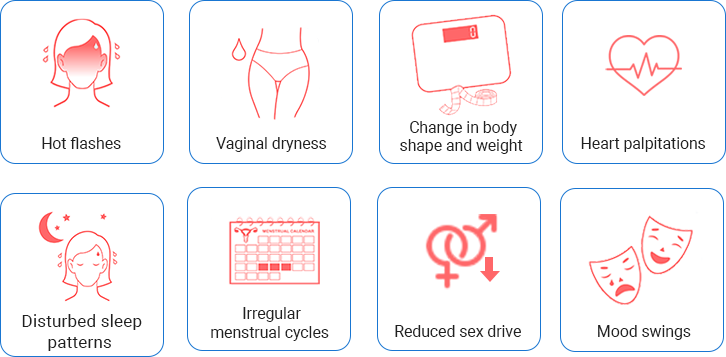A Guide to Menopause Symptoms, Stages and Changes
When Amber turned 48, she started noticing that her menstrual cycles were becoming irregular. Amber also found herself waking up several times at night, struggling to get back to sleep, and feeling unusually anxious and irritable during the day. As she was concerned about these changes, Amber consulted her gynaecologist, who explained that she was entering menopause.
Amber’s experience is like that of many women and highlights the importance of understanding this process and its impact on health and well-being.
What is Menopause
It is the time that marks the end of menstrual cycles. It’s diagnosed when you have gone 12 consecutive months without a menstrual period. It’s a natural process that occurs when your ovaries stop producing necessary reproductive hormones. If its due to surgery or medical treatment, it is called induced menopause.
Hormonal changes due to menopause cause uncomfortable physical and emotional symptoms. The physical symptoms, such as hot flashes and emotional symptoms of menopause, might disrupt sleep, lower energy and also affect emotional health. There are various effective treatments available, from hormone therapy to adjustments in lifestyle.
According to WHO, most women experience menopause between the ages of 45 and 55 years as a natural part of biological ageing. If it is before the age of 40 it is considered premature and can be due to medical conditions or certain treatments.
Stages of Menopause
Menopause is the permanent ending of menstruation, but the process is gradual and happens in three stages:
Perimenopause – Also known as menopause transition, begins eight to ten years prior. In this stage, ovaries slowly produce less oestrogen. It usually starts in the 40s and can last for several months to several years. In this stage, many begin to experience symptoms such as irregular periods, hot flashes and mood swings.
Menopause – This is the stage where menstrual periods stop. Ovaries don’t release eggs and there is a significant decrease in oestrogen and progesterone production. Healthcare provider diagnoses this when you have gone without a period for 12 consecutive months. Unlike the other two stages, this stage itself is a defined moment and hence, you do not stay in this stage.
Postmenopause: This is the stage after menopause where you stay for the rest of your life. While most of the menopause symptoms ease up in postmenopause, you can still have mild menopausal symptoms for several years in this stage. Additionally, people in the postmenopause stage are at an increased risk of osteoporosis and heart diseases due to low oestrogen levels.
Hormonal Changes Within Each Stage
Perimenopause: During this stage, oestrogen and progesterone levels begin to decline. As these hormones fluctuate significantly, it leads to irregular menstrual cycles and symptoms such as hot flashes, night sweats, weight changes and sleep disturbances.
Menopause: The ovaries produce very little oestrogen and progesterone. Due to the sudden drop in these hormones, it triggers many of the common symptoms of menopause, such as hot flashes, night sweats, and mood changes.
Postmenopause: Oestrogen levels remain low, and the body adjusts to these lower hormone levels. But the reduction in oestrogen may lead to increased health risks, such as osteoporosis and cardiovascular disease.
What are the menopause symptoms?

The menopause symptoms vary widely among women and can range from mild to severe. Common symptoms include:
- Irregular periods or periods that are heavier or lighter than usual.
- Hot flashes are also known as vasomotor symptoms (a sudden feeling of warmth that spreads over your body).
- Night sweats and cold flashes.
- Vaginal dryness that causes discomfort during sex.
- Urinary urgency (a pressing need to pee more frequently).
- Difficulty sleeping.
- Emotional changes (irritability, mood swings or depression).
- Dry skin, dry eyes or dry mouth.
Some people might also experience:
- Racing heart.
- Headaches.
- Joint and muscle aches and pains.
- Changes in libido (sex drive).
- Difficulty concentrating or memory lapses (often temporary).
- Weight gain.
- Hair loss or thinning.
Changes in the hormone levels cause these symptoms. Some people have intense symptoms of menopause, while others have mild symptoms. Not everyone will have the same symptoms as they transition to menopause.
Contact a healthcare provider if you’re unsure if your symptoms are related to menopause or another health condition.
Why Does Menopause Happen?
When menopause happens on its own, i.e., it’s a natural menopause, it’s a natural ageing process. Menopause is when you go a complete year without periods without any surgery or medical conditions.
As you age, the reproductive cycle slows down and prepares to stop. This cycle has been continuously functioning since puberty, and as menopause nears, the ovaries produce less oestrogen. When this decrease occurs, the menstrual cycle (period) starts to change. It can become irregular and then stop.
Physical changes can also happen as your body adapts to different hormone levels. The symptoms you experience during each stage of menopause are all part of your body’s adjustment to these changes.
What are the health risks of menopause?
Healthcare providers may want to keep a close eye on your health as, due to low oestrogen levels, you are at higher risk for conditions like osteoporosis and cardiovascular diseases after menopause. You might get prescribed treatment if necessary.
Osteoporosis
Osteoporosis occurs when the insides of your bones become less dense, making them more fragile and likely to fracture. Oestrogen plays an important role in preserving bone mass, and it signals bone cells to stop breaking down.
People lose an average of 25% of their bone mass from the time of menopause to age 60. This is largely because of the loss of oestrogen. Your healthcare provider may want to test the strength of your bones over time. Bone mineral density testing, also called bone densitometry, is a quick way to see how much calcium you have in certain parts of your bones.
Cardiovascular diseases
After menopause, the risk for cardiovascular disease likely increases because of several things like:
- The loss of oestrogen.
- Increased blood pressure.
- Certain lifestyle habits like smoking cigarettes, drinking alcohol or eating unhealthy foods (if these habits apply to you).
- A decrease in physical activity, which can lead to high cholesterol and other conditions (depending on your activity levels after menopause).
Menopause is a natural part of ageing and comes with physical and emotional changes. Understanding these changes and their health risks helps women manage this transition more effectively. Regular checkups, a healthy lifestyle and awareness of symptoms are important in the menopausal journey. Support and understanding are important in maintaining the health and well-being during and after menopause.
FAQs
What is premature menopause?
Natural menopause occurs between the ages of 45 to 55, and it’s a normal ageing process. Menopause that occurs before the age of 45 is called early menopause. Menopause that occurs at 40 or younger is considered premature menopause. When there’s no medical or surgical cause for premature menopause, it’s called primary ovarian insufficiency.
How long does menopause last?
Menopause is a point in time when you don’t stay in menopause. You reach it when you haven’t gotten a menstrual period for one year. Immediately after you reach menopause, you move into postmenopause. This stage lasts for the rest of your life.
How long do you have symptoms of menopause?
The symptoms of menopause can last for up to 10 years before it officially occurs. The average length of menopause symptoms is about seven years. Most people say their symptoms ease up or disappear completely once they reach postmenopause.
Disclaimer: Please note that the information is strictly for informative purposes. It is not intended to be used in lieu of professional medical advice, inclusive of diagnosis or treatment. It is strongly advised that you seek a doctor’s medical advice on any treatment or medical condition that you learn about.

